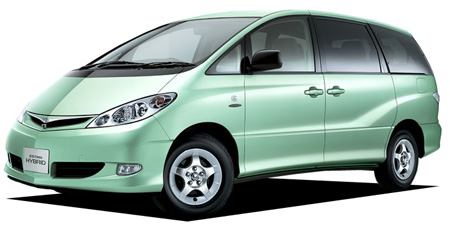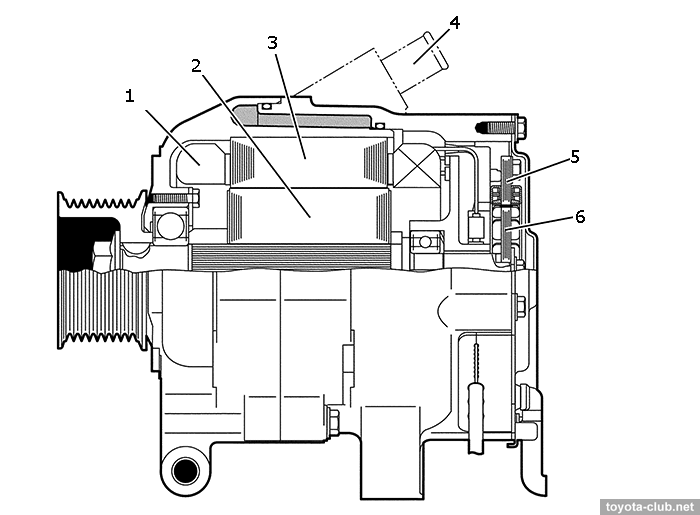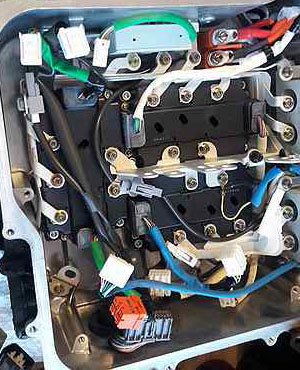|
Eugenio,77
mail@toyota-club.net
© Toyota-Club.Net
Nov 2021
The first generation Toyota Estima and Alphard Hybrid are still quite common in emerging markets, so it makes sense to remind of the differences between these models and other Toyota hybrids.
Estima Hybrid AHR10W
2001-2005 |
 |
Alphard Hybrid ATH10W
2003-2008 |
 |
•
Historically, the AHR10W and ATH10W with 'E-Four' were the first all-wheel drive hybrids. But their real uniqueness is different - only Estima and Alphard were equipped with THS-C hybrid system, using a real V-belt CVT. The rest of Toyota's hybrids on front-wheel drive platforms received the well-known planetary transmissions designated as 'eCVT'.
|
1 - engine (2AZ-FXE), 2 - inverter/converter, 3 - engine control unit, 4 - HV battery module, 5 - rear transaxle Q210, 6 - HV battery pack (HV battery computer, system main relay), 7 - HV control computer, 8 - front transaxle P210 (motor generator, power switching mechanism, CVT, oil pump)
|
•
The front transaxle P210 is built using CVT K110 components. Unlike other Toyota CVTs, there is no torque converter, unlike other hybrids - there is only one motor-generator.
The 1EM electric motor is quite a weak - 13 kW and 110 nm (for comparison, the Prius NHW20 drive motor - 50 kW and 400 nm).
P210 is the only Toyota hybrid transmission that needs to be filled with CVT fluid TC.
|
1 - motor-generator, 2 - permanent magnet, 3 - damper, 4 - speed sensor, 5 - rotor, 6 - coil, 7 - stator, 8 - clutch C1, 9 - brake B1, 10 - clutch C2, 11 - differential, 12 - CVT section, 13 - power switching mechanism (PSM), 14 - from inverter
|
If the PSD (Power Split Device) in conventional hybrids does not have any controlled friction elements at all, a simple CVT contains reverse brake and forward clutch, here the PSM (power switching mechanism) includes a brake and two clutches.
|
1 - planetary gear, 2 - brake B1, 3 - clutch C1, 4 - clutch C2, 5 - CVT, 6 - sun gear, 7 - motor-generator (planetary carrier), 8 - stator coil, 9 - input shaft (sun gear), 10 - power switching mechanism (PSM), 11 - motor-generator, 12 - from engine, 13 - ring gear, 14 - to reduction gear and differential.
|
• Rear transaxle Q210 is largely similar to other three-shaft units of E-Four. The 1FM electric motor also does not stand out in terms of performance - 18 kW and 108 Nm. Reduction gears for Estima and Alphard differ in gear ratios - 6.311 and 6.859.
1 - motor generator (MGR), 2 - counter drive gear, 3 - counter driven gear, 4 - differential drive pinion gear, 5 - differential ring gear, 6 - differential gear unit.
|
• The engine is equipped with an external starter-generator (high-voltage, liquid-cooled, 6.2 kw / 37 nm), connected via drive belt to the crankshaft pulley. Its main function is to start the engine while the hybrid system is running (first start is by MG), and in some conditions it serves as an auxiliary generator.
|
1 - coil, 2 - rotor, 3 - stator, 4 - coolant union, 5 - speed sensor (resolver), 6 - rotor (resolver)
|
•
The inverter includes as many as five power modules - for MG, MGR, starter-generator, A/C compressor, oil pump.
|
1 - HV battery, 2 - body ground, 3 - from ignition switch, 4 - inverter/converter, 5 - current sensor, 6 - control circuit, 7 - A/C computer, 8 - A/C compressor motor, 9 - oil pump motor, 10 - starter-generator, 11 - MGR, 12 - HV control unit, 13 - MG
|
IGBT modules are commonly identified by the color of the sheath of the wire harness connected to them: green - for the starter-generator, white - for the rear motor-generator (MGR), blue - for the main motor-generator (MG), black - for CVT/EHPS pump (the last is located at the lower part of the inverter case). The module for A/C compressor is visually distinguished by its plastic housing.
The cooling circuit of the inverter is independent of the engine cooling circuit, but it uses a separate section of the common radiator.
|
1 - cover, 2 - circuit breaker sensor, 3 - inverter/converter, 4 - MG, 5 - inverter cooling pump, 6 - radiator, 7 - engine section, 8 - hybrid section, 9 - to engine, 10 - from engine
|
•
The high-voltage battery module (216V) is located under the front seats, the inlet and outlet of air for cooling the cells is located in the rear passenger footwell.
• Combined power steering pump and CVT fluid pump are driven by a high voltage electric motor, that cooled with CVTF.
|
1 - power steering oil pump, 2 - motor, 3 - CVT oil pump
|
• The hydraulic power steering made it necessary to implement an unusual for Toyota EHPS type with an electric pump on these hybrids.
|
1 - power steering oil pump, 2 - motor, 3 - steering rack
|
• The variable displacement air conditioner compressor received a double drive - by a belt from the engine or from an electric motor built into the pulley (on the very first Estima's, only belt drive was used).

|
Hybrid repair experts have called the first generation Estima (AHR10) Toyota's most problematic hybrid vehicle ever.
And this is true: all the traditional defects known since the time of the first Prius, the consequences of the rear drive module addition; CVT instead of an absolutely reliable planetary transmission; and even AZ engines, especially of the early series, can hardly be called successful.
Contrary to popular beliefs, the weakest and most problematic point of hybrids is not the high-voltage battery, but the inverter. The easiest way to destroy it is through clogged radiator fins or pump problems, so among the do-it-yourself creativity, it is common to install a separate radiator for the inverter cooling circuit and more efficient and reliable pumps, as well as preventive replacement of thermal paste under the modules.
MGR-related inverter module fails frequently and for various reasons: from overheat of the inverter to excessive load due to mechanical problems in the rear drive module or during rather lights off-road exercises. The module responsible for the starter-generator, in addition to overheat, suffers from a short to ground in the SG coils, as well as from the slightest difficulties with ICE starting. Of course, before replacing a burned-out IGBT module, it is necessary to find and eliminate the root cause of its failure.
The high-voltage batteries of these models cannot be called problem-free, but their cells are identical with many other models (and first of all, with the popular Prius), that makes these problems quite solvable.
Although otherwise the uniqueness means a very limited choice of "donor organs" - interchangeability with other hybrids is a really poor.
The general problem of hybrids is that for their successful and non-costly repair, either the qualification of specialists, or practice, specific skills and a compilation of folk experience are required. Whereas today these cars often find themselves in conditions where the only available professional is a bike repairman.
And the best advice regarding Estima AHR10 / Alphard ATH10, which can be given to colleagues from other countries and continents - start your introduction to the world of Toyota hybrids from any other model.
|
Toyota Hybrids and EVs:
·
E-Four AWD ·
THS-C system ·
HEV transmissions ·
BEV/FCEV transmissions ·
Trucks ·
Typology ·
|
|
|














